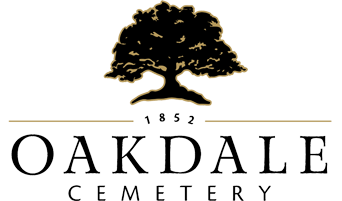About Oakdale Cemetery
By Janet Seapker
Oakdale was part of the Rural Cemetery Movement that swept the US in the mid-Nineteenth Century. Rural cemeteries converted large tracts of land into garden settings. As families purchased lots, they mixed ornamental plants in with the native vegetation, making Oakdale one of the city’s most beautiful spots. The cemetery is resplendent with blooming plants all year around, but especially so in the spring.
In 1852, prominent Wilmington businessmen purchased 65 acres for a new cemetery to be located beyond the town limits, which was 8th Street. The cemetery became known as Oakdale and was North Carolina’s first rural Cemetery. The first burial occurred on February 5, 1855—Annie DeRosset, the six-year old daughter of the cemetery president, Dr. Armand John DeRosset.
Oakdale Cemetery contains the graves of the movers and shakers of Wilmington, NC. The eloquent epitaphs and symbolic funerary art tell stories of those who lie beneath and bring them to life for the living. The graves represent veterans from all wars and all branches of service, politicians, mayors, congressmen, artists, architects, writers, developers, merchants, planters, fraternal order members, insurance men, exporters, immigrants, victims of Yellow Fever epidemics, wives, mothers, infants and children, and a female Confederate spy.
Oakdale is an active cemetery conducting burials and selling lots. The Board of Directors of the non-profit Oakdale Cemetery Company oversees the development of land and future planning for the cemetery.
A Rural Cemetery
During the 19th Century, the rural Cemetery Movement emerged as an alternative to crowded urban, generally church graveyards. Oakdale exemplifies this movement. In the romantic spirit of the Victorian era, the rural cemetery generally was located on hilly terrain and featured winding paths, large shade trees, flowers and shrubs, and appealing vistas. It was meant for the living as well as departed loved ones—just like Oakdale today. The rural Cemetery concept was a forerunner of public park development in America.
Rural cemeteries began in 1831 with the opening of Mount Auburn in Cambridge, near Boston, Massachusetts. A succession followed, among which were:
- Laurel Hill, Philadelphia, 1836
- Greenmount, Baltimore, 1838
- Spring Grove, Cincinnati, 1844
- Allegheny, Pittsburgh, 1845
- Hollywood, Richmond, 1847
- Elmwood, Detroit, 1849
- Magnolia, Charleston, 1850
- Oakland, Atlanta, 1850
- Calvary & Rosehill, Chicago, 1859
- Cedar Hill, Hartford, 1863
